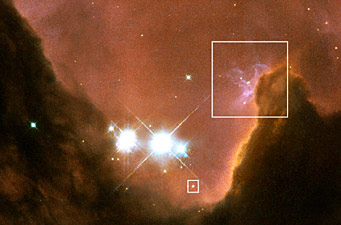Most stars are born in clusters rather than singly, and there’s plenty of evidence that the Sun was too.

This Hubble closeup of part of the Trifid Nebula in Sagittarius shows the kind of environment where the Sun and solar system were probably born. Massive hot stars dominate the scene; they will run through their brief lives quickly and explode as supernovae. The larger white box shows several more modest stars that recently formed in the retreating gas-and-dust pillar to their right. The small box highlights a "proplyd," a protoplanetary disk around a star that may end up like our Sun. Click the image for larger versions and for more information on this scene.
NASA / ESA / Hubble Heritage Team (AURA / STScI)
For one thing, the material of the infant solar system (as preserved in the earliest meteorites) was enriched by fresh supernova debris from at least one very young, massive star (having 15 to 25 solar masses) that exploded less than 5 light-years away, no more than 2 million years after the Sun's formation. Today no such massive star exists within 300 light-years of the Sun. Clearly, the early solar system had stars close around it.
But that was 4.57 billion years ago. Where are the Sun’s cluster-mates now?
Some of them, it turns out, should remain surprisingly nearby. An analysis by Simon F. Portegies Zwart (University of Amsterdam) finds that the Sun’s birth cluster started off with about 500 to 3,000 solar masses and a diameter smaller than about 20 light-years — typical for open clusters. Evidence for the cluster's mass and size, Zwart writes, is preserved in the anomalous chemical abundances and structure of the solar system's Kuiper Belt — the realm of small, icy objects out beyond Neptune. Some of the Kuiper Belt's objects are dynamically "hot"; they were stirred up and scattered by the gravity of at least one nearby cluster star making a close pass in early days.
Like other open clusters, the Sun's birth cluster disintegrated with time. Most of its stars have long since drifted away and are mixed irretrievably into the swarms of the Milky Way — strung out during the approximately 27 orbits that they and the Sun have made around the galaxy since their origin long ago.
However, about 10 to 60 of the Sun's nestmates (a few percent) should still remain closer than 300 light-years from us and are still traveling in parallel with us, according to Portegies Zwart. The European Space Agency's upcoming Gaia astrometry satellite should be able to sort them out by their space motions. Their exact chemical abundances might then give them away for sure.
“Finding even a few,” writes Portegies Zwart, “will strongly constrain the parameters of the parental star cluster and the location in the Galaxy where we were born.”
Don't expect them to look like anything special, though. The Sun is very ordinary among stars, and so were the circumstances of its origin.
A draft preprint of the research paper appears on the Astro-ph preprint server (March 2, 2009).
 4
4
Comments
Michael C. Emmert
March 17, 2009 at 2:33 pm
The Sun's birth cluster is a very interesting subject. The dynamical interactions there might result in binary star systems forming. The original giant molecular cloud contracted and as a result, it's spin increased. This spin causes the cloud to break into two clouds, which continue to collapse and spin faster and break up all the way down to stellar masses. After stars form then further interactions may create new binaries, cause the binaries to contract, or break them apart into single stars, Does the Sun have a binary companion? After the cluster breaks up random passing stars have the potential of breaking the binaries up or modifying their orbits in various ways. If, however, the Sun has a companion, it would have to be less than 45 Jupiter masses or existing surveys would have spotted it by now. I'd like to see a good far infrared survey.
You must be logged in to post a comment.
Michael C. Emmert
March 17, 2009 at 2:33 pm
The Sun's birth cluster is a very interesting subject. The dynamical interactions there might result in binary star systems forming. The original giant molecular cloud contracted and as a result, it's spin increased. This spin causes the cloud to break into two clouds, which continue to collapse and spin faster and break up all the way down to stellar masses. After stars form then further interactions may create new binaries, cause the binaries to contract, or break them apart into single stars, Does the Sun have a binary companion? After the cluster breaks up random passing stars have the potential of breaking the binaries up or modifying their orbits in various ways. If, however, the Sun has a companion, it would have to be less than 45 Jupiter masses or existing surveys would have spotted it by now. I'd like to see a good far infrared survey.
You must be logged in to post a comment.
Saul Levy
March 17, 2009 at 2:56 pm
Many IR surveys have been done, both from the ground and from space with satellites. IR research is one of the main fields of stellar astronomy.
No solar companion was found.
Saul Levy
You must be logged in to post a comment.
George the Ace Of Space
March 21, 2009 at 9:25 pm
Who's the Pink Floyd fan at Sky & Tel? I appreciate the reference. Wasn't "Set The Controls For The Heart Of The Sun" from the "Umaguma" album?
You must be logged in to post a comment.
You must be logged in to post a comment.